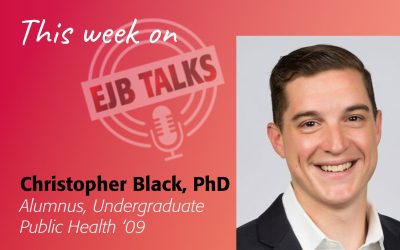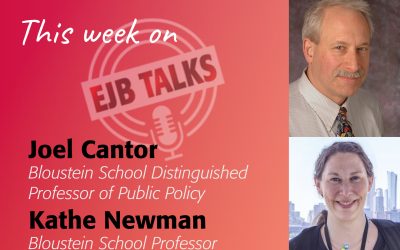EJB Talks returns for its third season! Stuart Shapiro will kick off 2021 by looking forward after a year of tumult to the post-pandemic world in health, planning and policy. In this first episode, he talks with Associate Dean and Professor, Clint Andrews, about the future of urban planning and how smart building technologies contribute to safety and improving the environment. They also discuss how behavioral changes arising from COVID19 will likely affect building decisions and urban planning trends for decades to come.
Stuart Shapiro
Welcome to season three of EJBTalks. I’m Stuart Shapiro, the Associate Dean of the Faculty at the Bloustein School, and the purpose of this podcast is to talk with my colleagues and our alumni about policy, planning and health, the interaction between these issues and how they affect people in New Jersey, the United States and the world.
We’re going to start this season by looking forward. While we’re still in the midst of a global pandemic and a recession, many of my colleagues have been giving much thought to what the world will look like as we emerge from the chaos of the past year. Today, I’m very happy to be talking with my fellow Associate Dean Clint Andrews, a Professor in our nationally ranked urban planning program, and also in our new public in urban informatics program. Welcome to the podcast Clint.
Clint Andrews
Thanks so much Stu.
Stuart Shapiro
A lot of your recent work has been about smart buildings. Let’s start out with sort of a definition here. What are smart buildings and talk a little bit about your work on them?
Clint Andrews
Sure. So a smart building is just a regular building first of all, but it does have extra sensors and information and communication technologies embedded in it that help to manage comfort levels for people inside the building, and their security, and to make the systems operate more efficiently. And so it’s the kind of thing that you see in both new buildings and in retrofits, and you know, commercial buildings, offices, and so forth. And also at home. And most of us are familiar with Alexa and Siri and Google. And those are good analogies for what a smart building might do, you end up creating kind of an ecosystem of electronics services that feed through this central brain.
Stuart Shapiro
So you’d be able to talk to your furnace or to your refrigerator the way you talk to, and I’m hesitant to say Alexa’s name too loudly, or else she’ll respond here. But you could talk to the other parts of your building as well?
Clint Andrews
That’s possible, although that’s not the main focus of smart building technologies, it’s much more about the different pieces of equipment talking amongst themselves about you.
Stuart Shapiro
(Laughing) All right, I’m gonna put the alarming aspect of that aside for the moment. Let’s talk though, about sort of what need this fills. What’s making these smart buildings more desirable or even necessary?
Clint Andrews
Part of it is realizing that we are using a variety of resources in a kind of a profligate manner. And so there’s a real efficiency drive at the heart of the smart building movement that wants us to use energy more efficiently, because if we don’t, then the fossil fuels get burned and increase the rate of global warming. So that’s definitely part of it. Another part is that security has become a serious issue for many enterprises. It’s actually less of an issue at home for most people than it is in commercial and institutional buildings as just a couple of days ago, the US Capitol experienced. And so that’s part of the story.
And you can think about how this might play out in a city where there might be millions of people on the streets, but only a small number of them really should have access to a building. And so you want to have a security guard who says, “okay, you’re allowed in, but have tosho w me your ID.” Maybe it’s automated to some extent, and there are swipe cards; maybe it will be automated further, and they’ll use biometric techniques to say, “okay, the pattern in your eyeballs is correct. You really are allowed in.” Or maybe they’ll use your gait and say, “Yep, you walk like Stuart, so you’re allowed in the building.”
Stuart Shapiro
Oh, wow, that’s fascinating. So we think of office buildings, we might see these more in the commercial sector than the residential sector, at least sooner.
Clint Andrews
We certainly have had that already for decades now. So we’ve had these enhanced security systems at least since 2001, in pretty much all government buildings and many commercial buildings, especially in the finance sector. But we have had even for an even longer period. Control systems that try to maintain, let’s say thermal comfort, to make sure you’re not too hot or cold in your building.
And sometimes it’s as simple as the old Honeywell thermostat on your wall, or that kind of circular thing that you can either turn up or down. And that’s it. Or much, much more elaborate systems that we see in office buildings and in let’s say, wet labs and places like that, where they are really paying attention to all sorts of cues, you know, what’s the carbon dioxide level inside it? What’s the temperature inside? What’s the humidity level inside? All of those kinds of issues? And that’s been around for half a century at least.
Stuart Shapiro
So is this a developed-world phenomenon? Or do you see this more in the developing world? What parts of our planet are we seeing these more on?
Clint Andrews
You definitely see the smart technologies entering where people have money. And so it is pretty standard in the larger buildings that we build in North America. It’s also completely standard in the high-end buildings that are built all over the developing world. Although you aren’t going to see it in a shantytown or a favela except in the form of an Alexa or a Siri.
Stuart Shapiro
Right, that makes sense. You mentioned climate change already. What kind of magnitude of impacts can smart buildings have in terms of climate change? Now, obviously, there’s a lot of different areas, we have to, you know, we have to have more efficient cars, we have to have more efficient power plants, all that, what kind of contribution can smart buildings make?
Clint Andrews
It’s definitely in the sort of 10% range, it’s not going to solve the problem all by itself. Instead, it’s an enabler, it lets you shave a few points of waste off of, let’s say, your heating system because it will be able to tell the pumps that push the hot water around the building, “oh, look, that zone over there doesn’t need as much heat as normal”. So we can dial back the amount of water pumped. And so that helps on the order of 10 to 15% in improving energy efficiency.
But there’s a second dimension, which is more of a game-changer. And that’s that a smart building is a prerequisite to a smart utility infrastructure and a smart city. And so once buildings can talk to electric meters, can talk to the electric grid, then we start to open up many more possibilities that include things like electrifying more of the economy, and thereby being able to rely on renewable energy less than on fossil-fueled energy sources. And so part of… an important part of the story is this way it allows game-changers to come into being.
Stuart Shapiro
So you know, I’m a policy person. I’m going to ask, are we seeing mandates for these buildings? Are we seeing incentives for these buildings? How, what role can the government in the public sector play in encouraging the kind of network gains that you’re talking about there?
Clint Andrews
There’s an important distinction here between the roles they can play and the roles they are typically playing. And so what they can do is they can certainly either mandate the use of certain styles of technologies or incentivize them. And we see this very unevenly. If you look at the state level–which is where an awful lot of energy policy takes place in the United States–you’ll see a state like Colorado, encouraging smart metering infrastructure, which is kind of a gateway technology for smart buildings. And you see, New Jersey is a good example actually, where they are resisting mandating the use of smart metering because they are skeptical of the benefits, and worried that it’s an unnecessary cost.
Now, the other things that are happening that we can thank the government for are a lot of sponsored research in this area. This is a major area, a major focus of the U.S. Department of Energy’s Building Technologies Office. It also in the spirit of what’s known as the “smart and connected communities” portion of the National Science Foundation. It’s receiving a fair amount of support that way, especially on this part of trying to connect smart buildings to smart utilities to smart cities. And then, the final thing I’ll mention is standards, none of this stuff works very well unless there’s some agreement on standards that allow a true ecosystem of devices to be able to talk with one another.
Stuart Shapiro
Gotcha. And do those standards come from the public sector or the private sector, like they do with ISO or other programs develop them on their own,
Clint Andrews
Typically, the private sector develops them on its own. So there will be like the IEEE standard for that allows us to have Wi-Fi, and to have Wi-Fi that works all over the world. But then those standards that are developed by IEEE, or ISO, or one of the other entities, then get recognized in official documents, like building codes and legislation where it’s common to refer to, let’s say, ASHRAE standard 90.1. That’s the level at which buildings should perform if they’re going to be legal in this country.
Stuart Shapiro
I see. Great. Well, I want to wrap up with a couple of questions connecting all of this to our current moment. This podcast started in the wake of the COVID 19 pandemic. And now, as you know, things are very dark, but hopefully there’s an end sometime in 2021. How has the experience of the past year affected urban planning in general, and building trends in particular,
Clint Andrews
I think the COVID experience, especially, has really led us to question some very fundamental assumptions about what’s the role of the built environment? And does it really make sense to do all these behaviors that have become kind of ingrained? Like, should there be a daily commute? Do we, should we work in different places than we live? That certainly wasn’t common a few 100 years ago, but it became common, enabled by the automobile, among others. And so we are revisiting that.
In a way, urban planning reacts to what people do rather than leading. And so part of it is going to depend on many individual decisions by corporate leaders or people on the job deciding when to go back, or how many days a week to do the telecommute. And so that’s one way in which things are changing. We’re basically having discussions we haven’t had in probably 100 years. And that’s exciting. It opens up lots of potentials. It’s also terrifying, of course, especially if you have any money invested in real estate.
Stuart Shapiro
Right, it is. I mean, my perception is that there is, you know that this is a field of study that’s going to be decades-long now in terms of how what’s going on right now, what’s gone on since March of 2020, affects a wide variety of fields, transportation, etc. And I think you’ve hit on a big one, the working at home. I mean, I don’t think a lot of people are going back to work full time. And that is going to affect the built environment.
Clint Andrews
It absolutely is. Although I have to tell you, this is one of these areas where different segments of our population have different experiences. And you and I will not have to go back until our students finally demand to see us face to face to prove that we’re real. But there are other segments of the economy where you have to show up. Especially where there’s a lot of kind of either capital invested, so you know, humans need to serve those machines. Or where face to face service is valued. And we, you know, we’ve learned that even in that area, there are remote equivalents that we’re still not sure whether we value them to the same extent as to face to face. I suspect that we don’t, but they might be good enough substitutes for a variety of things. And all of this, I think adds further uncertainty about the future of work. And suddenly, the future of the built environment is going to echo the future of work.
Stuart Shapiro
Right. And, you know, as we dig our way out of this economic situation, the recession that we’re in, how we dig ourselves out is going to play a significant role and be affected by all of these things as well. So it does all tie together there. Any final thoughts on what our audience should know about the future of buildings, smart building and, and the urban environment?
Clint Andrews
Just a couple of thoughts that this is an area where there are several dynamics at play, and all of them are important. One is a demographic dynamic, an aging population, fewer children, continued migration. Continued both presence of very, very wealthy people, and very, very poor people. So that continues to be part of the background. The second thing that is always going to be there is the technology dynamic, we are going to continue innovating in this space. And a lot of it is going to affect what cities look like, but it’s also going to affect us as individuals.
Even…There’s a scary word that’s been popular out in Silicon Valley–transhumanism. And in a crude sense, that sort of says, we used to have to work at an office with a filing cabinet and a desk, and then we figured out how to put all that onto a computer. And then we figured out how to put all that onto our mobile phone that sits in our pocket. And then in another decade at a max, we’re going to figure out how to have that be a nice little dangly earring or a nice little subdermal implant, and we’re going to carry our office around just under our skin. And that is going to further change both the human experience and what we need from our built environment. And so it all these levels from the demographic to the very intimate, change is coming.
Stuart Shapiro
Wow. Well, we wanted to start this season sort of talking about the future and I think I think you’ve helped us to that in a very profound way. Thanks a lot for coming on Clint.
Clint Andrews
I’ve enjoyed it.
Stuart Shapiro
Also a big thank you to our production team, Amy Cobb and Karyn Olsen. We’ll be back next week with another talk from another expert from the Bloustein School. Until then, stay safe.




